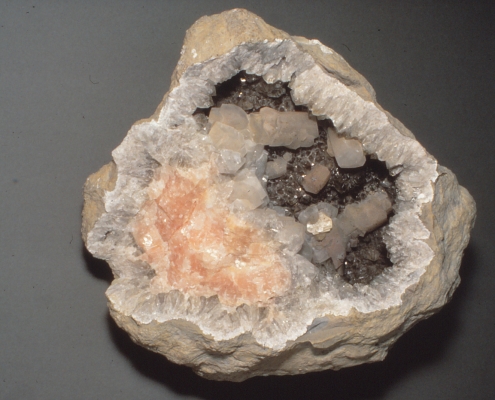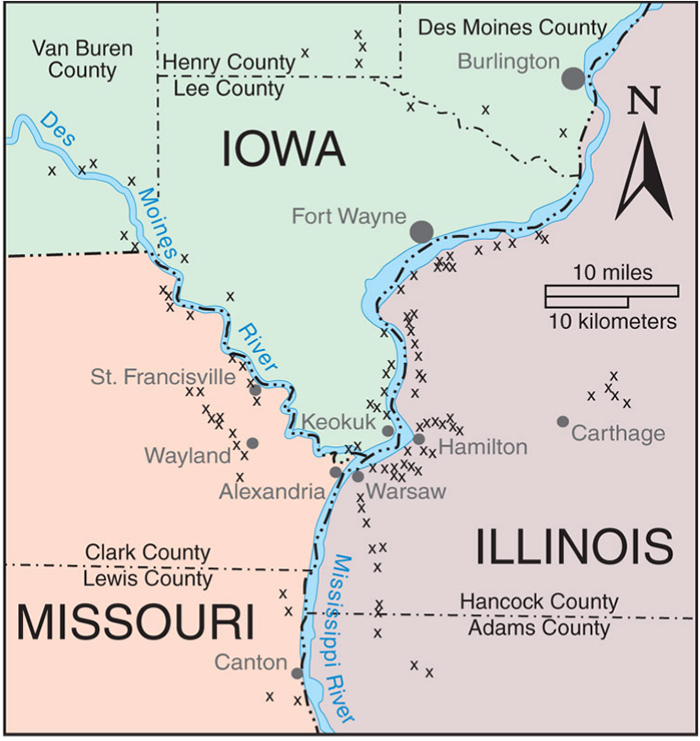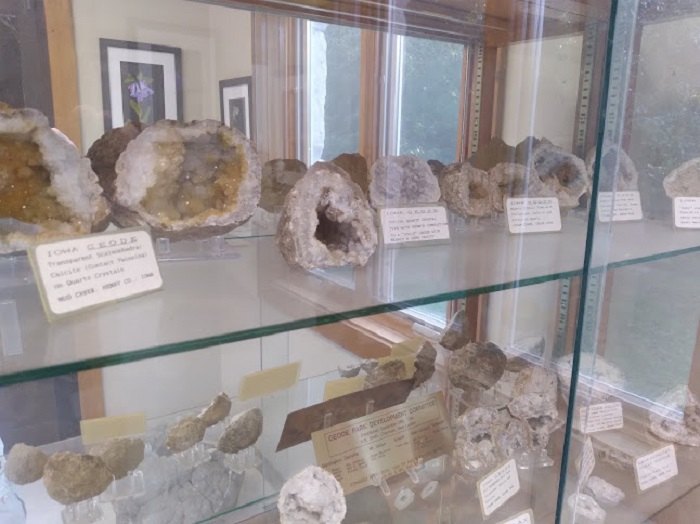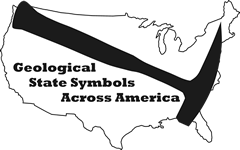Iowa
State Rock: Geode
S.J.R. 20, February 2, 1967
A Joint Resolution designating the Iowa geode as the official state rock for the state of Iowa.
WHEREAS, it is common practice for states to adopt specific flowers, birds, and trees as the official state flowers, state birds, and state trees, and
WHEREAS, it is also the practice among a number of states to adopt certain rocks as the official state rock of the state, and
WHEREAS, the state of Iowa does not at the present time have a rock as the official rock of the state, and
WHEREAS, Iowa has natural deposits of one of the rarest and most beautiful rocks in the example of the Iowa geode, and
WHEREAS, the Iowa geode is a much sought after brightly colored rock of a crystal formation and one of the finest geodes located in the nation, and
WHEREAS, Iowa is one of the few places where the geode formations are plentiful and found in some abundance, and
WHEREAS, a survey conducted through the use of questionnaires mailed to rock collectors in the state has indicated that the Iowa geode is the first choice for the official state rock of Iowa; NOW THEREFORE
Be It Resolved by the General Assembly of the State of Iowa:
Section 1. The Iowa geode is hereby designated and shall hereafter be officially known as the state rock of Iowa.
Sec. 2. The curator of the department of history and archives is hereby directed to obtain samples of the Iowa geode adequate to represent a fair sampling of the rock as found in this state and display the samplings 1n an appropriate place in the state historical library.
Sec. 3. The editor of the Iowa Official Register is hereby directed to include an appropriate picture with an appropriate commentary of the Iowa geode in the Iowa Official Register along with pictures of the state flower, state bird, and state tree.

An Iowa Geode. Image courtesy of the Iowa Geological Survey.
A geode is a hollow, or void, that is roughly spherical in shape in a rock in which minerals precipitate, forming (oftentimes) beautiful crystal displays. The voids in which geodes form are commonly found in limestones or volcanic rocks, and, although rarely, other rock varieties. These are then filled with mineral crystals that have slowly grown as water passes through the voids, depositing the minerals molecule by molecule. The minerals crystals are usually quartz (and all its varieties like amethyst) or calcite, but may be found as many other mineral varieties like barite or celestite. One of the notable features of a geode is that they are separable from the rock in which they occur and the crystals are notably different than the surrounding rock, making them more easily collectable than a lot of crystals or minerals that need to be dug out of place.

Map of Keokuk Geode localities. Image courtesy of Mindat.org and (C) William W. Besse
The beauty and abundance of the geodes found in Iowa were one of the reasons that they were named the State Rock, where they were even known globally as some of the best geodes on Earth. The identification of them as the State Rock was also to improve tourism with the goal in getting people into the state to go rock hunting. Geodes in Iowa are most notably found in the 35-miles surrounding Keokuk, prompting the name for these geodes, the "Keokuk geodes". Keokuk is found in the southeastern corner of Iowa, near the borders of Illinois and Missouri. These geodes formed in the Mississippian (353.8 - 342.8 Ma) lower Warsaw Formation, which is an amalgamation of shales, shaley dolomites, dolomites, and dolomitic limestones. The geodes are comprised of an outer shell of chalcedony, a microcrystalline variety of quartz. Chalcedony also coats the interior surface of many of the Keokuk geodes, forming a variety of colors including white, pink, grey, blue, yellow, and orange. And while most of the Keokuk geodes contain mainly quartz crystals, calcite is also common, as well as 17 other minerals.

Geode display at Geode State Park. Image courtesy of Onlyinyourstate.com.
There are also many places to find geodes in the area. There is even a state park named after the geodes: Geode State Park, however you are not allowed to collect geodes there. The park offices do have some displays with locally found geodes though. In the surrounding areas, there are many locations that can be found so that you can search for your very own geodes, however collecting should only be done on public land where collecting is approved or on private land with the permission of the landowner.
References
https://iowageologicalsurvey.uiowa.edu/iowa-geology/popular-interest/iowa-geodes
https://publications.iowa.gov/25569/1/2015-10-16_11-10-17_em-43.pdf
https://www.mindat.org/photo-540814.html
https://www.onlyinyourstate.com/iowa/geode-lake-ia/
https://rockhoundresource.com/iowa-rockhounding-location-guide-map/
Geology of Iowa's National Parks
Through Pictures
(at least the one's I have been to)
None yet!



